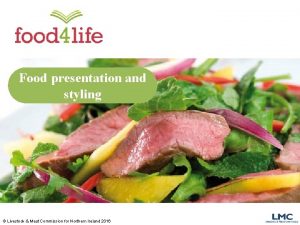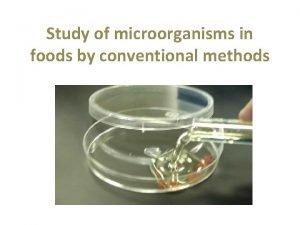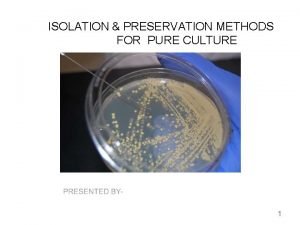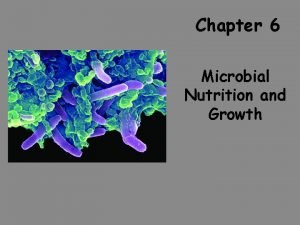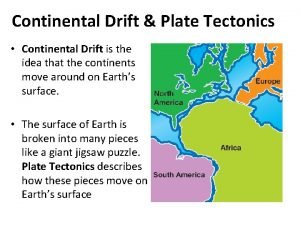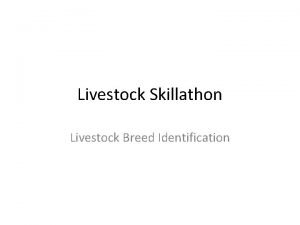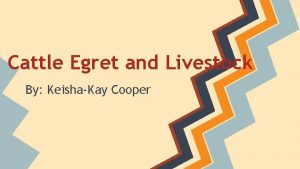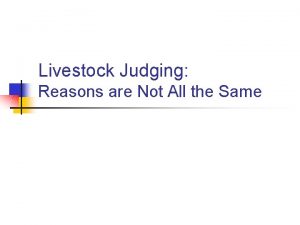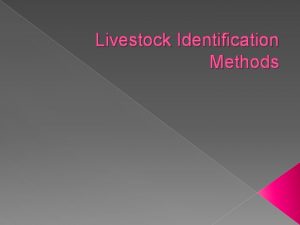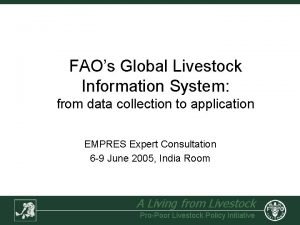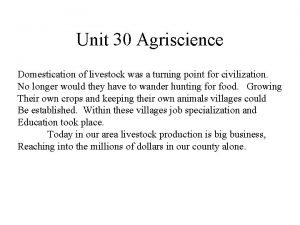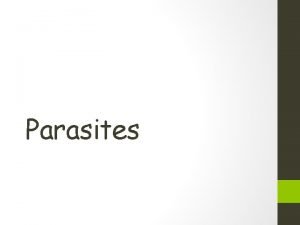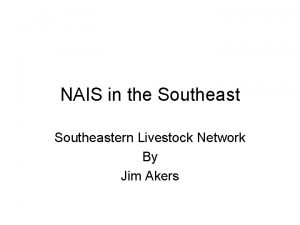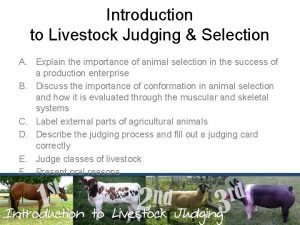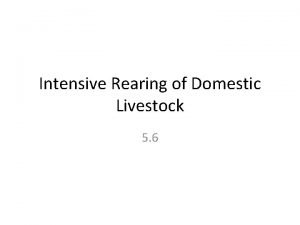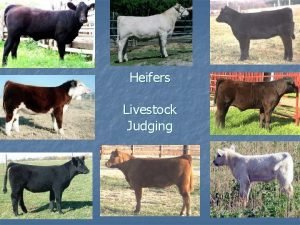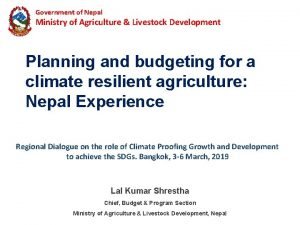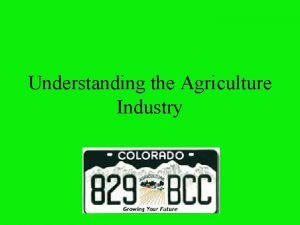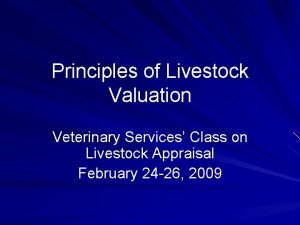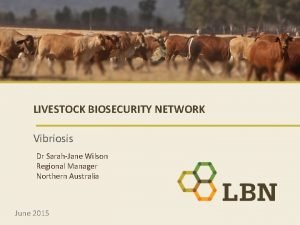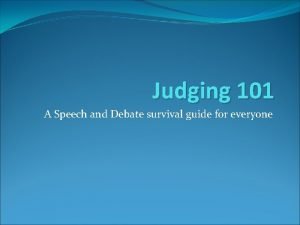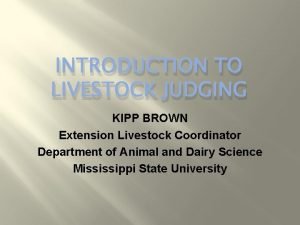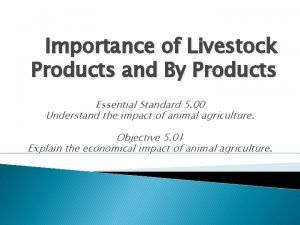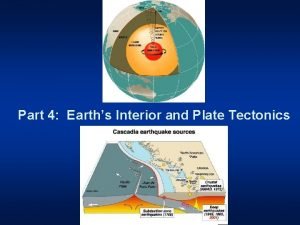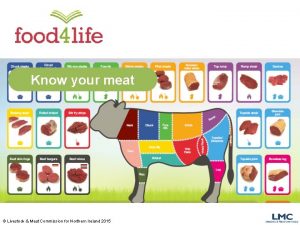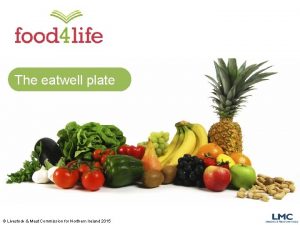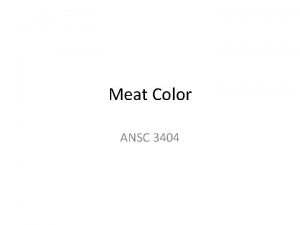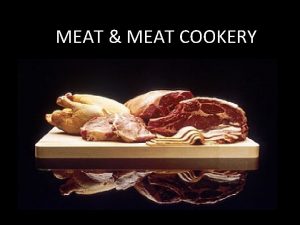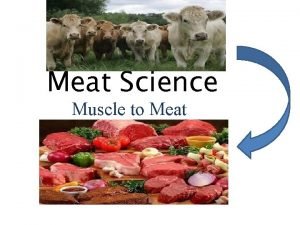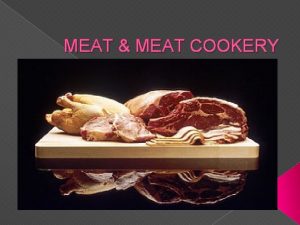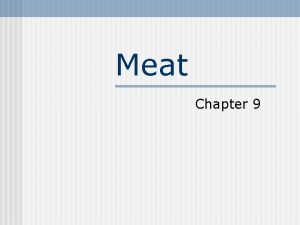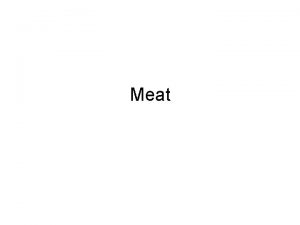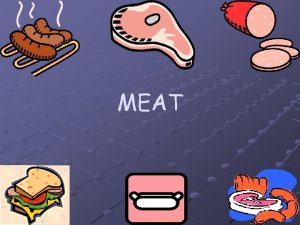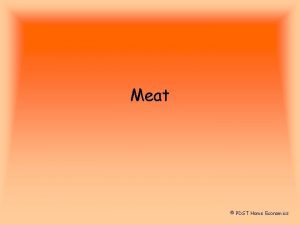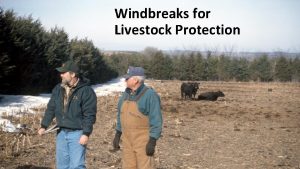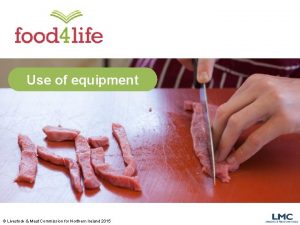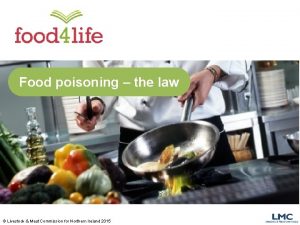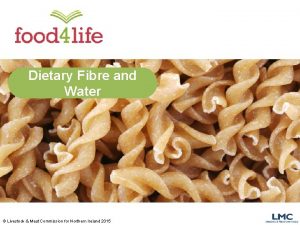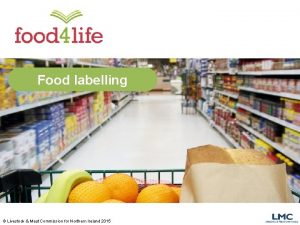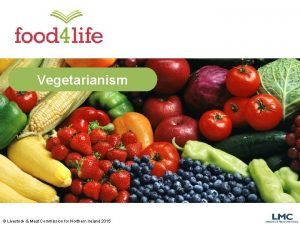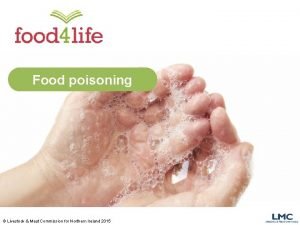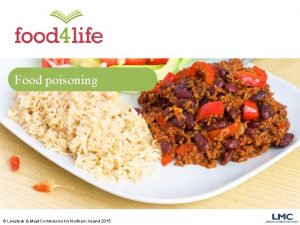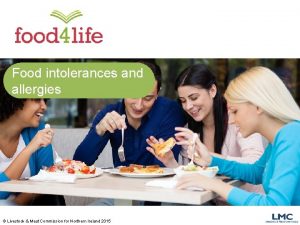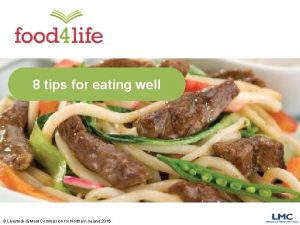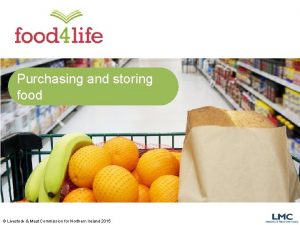Whats on the plate Livestock Meat Commission for






































- Slides: 38

What’s on the plate? © Livestock & Meat Commission for Northern Ireland 2015 2016

Learning outcomes Students will be able to: • explain how the Eatwell Guide helps consumers achieve a healthy and well-balanced diet; • identify the main nutrients provided by each food group. © Livestock & Meat Commission for Northern Ireland 2015 2016

A healthy, varied diet Apart from breastmilk as a food for babies, no single food contains all the essential nutrients the body needs to be healthy and function efficiently. The nutritional value of a person's diet depends on the overall balance of foods that is eaten over a period of time, as well as on the needs of the individual. A healthy diet is likely to include a variety of foods, from each of the main food groups, as this allows us to get all the nutrients that we need. All food and drinks can be part of a healthy diet but it is important to get the balance right! © Livestock & Meat Commission for Northern Ireland 2015 2016

The Eatwell Guide Public Health England (PHE) regularly reviews dietary recommendations as part of its role in promoting public health. In light of new evidence about our diet and health, particularly revised recommendations from the Scientific Advisory Committee on Nutrition (SACN) report on Carbohydrates and Health in 2015, a review of The eatwell plate was undertaken. As a result of the review, a new healthy eating guide for the UK has been developed. The Eatwell Guide. © Livestock & Meat Commission for Northern Ireland 2016

What changes can you see? © Livestock & Meat Commission for Northern Ireland 2015 2016

What has changed? The name has changed. Illustrations of foods and drinks are used. Guidance on healthy hydration has been added. A front-of-pack nutrition label has been added. The knife and fork have been removed. Foods high in fat and/or sugars have been removed from the purple segment. Additional messaging is provided for each food group.

What has changed? Fruit juice is now included in the hydration message (not illustrated pictorially in this group) but a maximum of 150 ml still counts as one portion of 5 A DAY. The purple segment now only contains unsaturated oils and fat spreads, which eaten in small amounts, provide the types of fat that are essential.

The Eatwell Guide There are many different models for food based dietary recommendations used around the world. The UK healthy eating model is called the Eatwell Guide. The Eatwell Guide is a guide to the proportion of foods we should eat from each food group to have a healthy, varied diet. © Livestock & Meat Commission for Northern Ireland 2015 2016

The Eatwell Guide – key messages The Eatwell Guide shows the proportions in which different groups of foods are needed in order to have a well-balanced and healthy diet. The proportions shown are representative of food eaten over a day or more, not necessarily at each meal time. Choose a variety of different foods from each food group to help get the wide range of nutrients the body needs to stay healthy. © Livestock & Meat Commission for Northern Ireland 2015 2016

The Eatwell Guide – key messages The Eatwell Guide applies to most people regardless of weight, dietary restrictions/preferences or ethnic origin. It does not apply to children under two years because they have different nutritional needs. Children aged two to five years should gradually move to eating the same foods as the rest of their family, in the proportions shown on the Eatwell Guide. © Livestock & Meat Commission for Northern Ireland 2016

The Eatwell Guide – key messages Anyone with special dietary requirements or medical needs might want to check with a registered dietitian on how to adapt the Eatwell Guide to meet their individual needs. The Eatwell Guide divides foods into groups, depending on their nutritional role and shows the proportions of each of the groups needed for a healthy, varied diet. © Livestock & Meat Commission for Northern Ireland 2016

Who is the Eatwell Guide for? 1. I am vegetarian, how do I use the Eatwell Guide when planning my diet? 2. My child is 1 year old and has an allergy to cows milk, do I use the Eatwell Guide to help me plan his diet? 3. My sister is pregnant, should I advise her to use the Eatwell Guide? 4. My friend is coming to stay with me for a week, she is Jewish. Can I use the Eatwell Guide guidelines to help me plan our meals? © Livestock & Meat Commission for Northern Ireland 2015 2016

The Eatwell Guide is made up of five food groups: • Fruit and vegetables; • Potatoes, bread, rice, pasta and other starchy carbohydrates; • Beans, pulses, fish, eggs, meat and other proteins; • Dairy and alternatives; • Oils and spreads. © Livestock & Meat Commission for Northern Ireland 2015 2016

The Eatwell Guide Look at the size of each of the food groups. What does this tell you about the proportions of each group? Most of what we eat should come from the two biggest food groups: • Fruit and vegetables; • Potatoes, bread, rice, pasta and other starchy carbohydrates. We should consume smaller amounts from the Beans, pulses, fish, eggs, meat and other proteins group and the Dairy and alternatives group. Only a very small amount from Oils and spreads group should be included. © Livestock & Meat Commission for Northern Ireland 2015 2016

Fruit and vegetables should make up just over one third of our daily food intake. Aim to eat at least five portions of fruit and vegetables each day. Choose from fresh, frozen, canned, dried or juiced. Choose a wide variety of fruits and vegetables as they all have different proportions of vitamins and minerals. Different fruit and vegetables contain: • vitamin C • vitamin A • folate • fibre • potassium and magnesium. They also contribute to the recommended daily intake of 30 g fibre. © Livestock & Meat Commission for Northern Ireland 2015 2016

What counts towards 5 A DAY? Fresh, frozen, dried, canned and juiced types. Fruit and vegetables cooked in dishes such as soups, stews or pasta dishes, or present in ready meals and shop bought sauces, soups and puddings. Fruit juice and smoothies also count towards fluid consumption. They are a source of free sugars so consumption should be limited to no more than a combined total of 150 ml per day. © Livestock & Meat Commission for Northern Ireland 2015 2016

What counts towards 5 A DAY? Beans and pulses count as a maximum of one portion a day no matter how many you eat. This is because they don't contain the same mixture of vitamins, minerals and other nutrients as fruit and vegetables. © Livestock & Meat Commission for Northern Ireland 2015 2016

What is a portion? One adult portion of fruit or vegetables is 80 g. For example: • one medium sized piece of fruit such as a banana, apple, pear, orange or nectarine; • two or more small fruits such as plums, satsumas, kiwi fruit or apricots; • a large handful of berries, cherries or grapes; • one heaped tablespoon of dried fruit such as raisins, cranberries or sultanas (you only need 30 g of dried fruit because the portion size is based on the weight of the fresh fruit); • one dessert bowl of salad; • three heaped tablespoons of vegetables or pulses (beans, lentils, chick peas). © Livestock & Meat Commission for Northern Ireland 2015 2016

Do you eat 5 A DAY? With just a little planning, we can make sure we get our 5 A DAY. Think about the following meal occasions, how could you include a portion of fruit or vegetables? Breakfast Dried or fresh fruit with cereal, glass of juice Mid morning snack Piece of fruit Lunch Add a bowl of salad Mid afternoon snack Vegetable sticks with hummus Dinner Mixed vegetables and canned fruit in juice © Livestock & Meat Commission for Northern Ireland 2015 2016

How we prepare fruit and vegetables can affect the nutrients they provide. What examples can you think of? Some vitamins can be lost in cooking water – can you name them? How can we minimise the loss of these vitamins? Oil, butter or creamy sauces should be used sparingly – Why? Adding fruit and vegetables to meals and dishes is a good way of reducing the energy density. What does this mean? © Livestock & Meat Commission for Northern Ireland 2015 2016

Potatoes, bread, rice, pasta and other starchy carbohydrates Just over one third of our total daily food intake should be from this group. Choose higher-fibre, wholegrain varieties such as wholewheat pasta, brown rice, or simply leave the skins on potatoes. Base your meals around starchy carbohydrate foods: • start the day with a wholegrain breakfast cereal; choose one lower in salt and sugars; • have a sandwich for lunch; • choose potatoes, pasta or rice as a base for your evening meal. © Livestock & Meat Commission for Northern Ireland 2015 2016

Potatoes, bread, rice, pasta and other starchy carbohydrates Wholegrain varieties usually contain more fibre, vitamins and minerals than refined versions. This group can provides carbohydrate, fibre, B vitamins, iron, calcium and folate. Wholegrain food includes: • wholemeal and wholegrain bread, pitta and chapatti; • wholewheat pasta; • brown rice; • wholegrain breakfast cereals and whole oats. © Livestock & Meat Commission for Northern Ireland 2015 2016

Potatoes, bread, rice, pasta and other starchy carbohydrates We should try to include at least one food from this group at each meal occasion. Starchy foods are often consumed as part of a composite dish. Can you think of some examples? • Breakfast … • Lunch … • Dinner … © Livestock & Meat Commission for Northern Ireland 2015 2016

Potatoes, bread, rice, pasta and other starchy carbohydrates Starchy foods are sometimes referred to as staple foods. These foods form the basis of diets around the world. What do you think the staple food is for: • Europe? • Asia? • South America? • Some parts of Africa? © Livestock & Meat Commission for Northern Ireland 2015 2016

Beans, pulses, fish, eggs, meat and other proteins These foods are sources of a range of nutrients including protein, vitamin D, vitamin B 12, zinc and omega-3 fatty acids so it is important to eat some foods from this group. Lean red meat, such as lean beef and lamb, can be consumed as part of a healthy, varied diet. Red meat is source of protein and provides a range of vitamins and minerals such as B vitamins, iron and zinc. © Livestock & Meat Commission for Northern Ireland 2015 2016

Beans, pulses, fish, eggs, meat and other proteins Some types of meat are high in fat, particularly saturated fat. When you are buying meat, remember that the type of cut or meat product you choose, and how you cook it, can make a big difference. To cut down on fat: • choose lean cuts of meat and go for leaner mince; • cut the fat off of meat and the skin off of chicken; • try to grill meat and fish instead of frying; • have a boiled or poached egg instead of fried. . © Livestock & Meat Commission for Northern Ireland 2016

What are the government recommendations for this group? The recommendations for this group are: • if you eat more than 90 g of red or processed meat a day try to cut down to no more than 70 g per day; • eat at least two portions of fish each week, one of which should be oily (e. g. salmon, mackerel, trout, sardines or fresh tuna). Oily fish provide long chain omega-3 fatty acids important for heart health; • beans and pulses such as kidney beans, chickpeas and lentils also count towards the 5 A DAY fruit and vegetable target. They can only be counted as a maximum of 1 per day regardless of how much is eaten. © Livestock & Meat Commission for Northern Ireland 2015 2016

Milk and dairy foods A moderate amount of these foods is needed in the diet. Try to have some milk and dairy food (or dairy alternatives) such as cheese, yoghurt and fromage frais. This group provides protein, calcium, iodine, vitamin B 12 and vitamin B 2 (riboflavin). Some dairy food can be high in fat and saturated fat, choose lower fat and lower sugar products where possible. Try: • 1% fat milk; • reduced fat cheese; • have a smaller amount of the full-fat varieties less often; • choose unsweetened, calcium-fortified versions when buying dairy alternatives. © Livestock & Meat Commission for Northern Ireland 2015 2016

Oils and spreads Although some fat in the diet is essential, generally we are eating too much saturated fat and need to reduce our consumption. Unsaturated fats are healthier fats that are usually from plant sources and in liquid form as oil, for example vegetable oil, rapeseed oil and olive oil. Swapping to unsaturated fats will help to reduce cholesterol in the blood, therefore it is important to get most of our fat from unsaturated oils. Choosing lower fat spreads is a good way to reduce your saturated fat intake. All types of fat are high in energy and should be limited in the diet. © Livestock & Meat Commission for Northern Ireland 2015 2016

Hydration Aim to drink 6 -8 glasses of fluid every day. Water, lower fat milk and sugar-free drinks, including tea and coffee all count. Fruit juice and smoothies count towards your fluid consumption. They are a source of free sugars so should be limited to no more than a combined total of 150 ml per day. Sugary drinks are one of the main contributors to excess sugar consumption amongst children and adults in the UK. Swap sugary soft drinks for diet, sugar-free or no added sugar varieties to reduce your sugar intake. © Livestock & Meat Commission for Northern Ireland 2016

Foods high in fat, salt and sugars This includes products such as chocolate, cakes, biscuits, full-sugar soft drinks, butter and ice cream. These foods are not needed in the diet. If they are included, have infrequently and in small amounts. If you consume these foods and drinks often, try to limit your intake so you have them less often and in smaller amounts. Food and drinks high in fat and sugar contain lots of energy, particularly when you have large servings. Check the label and avoid foods which are high in fat, salt and sugar! © Livestock & Meat Commission for Northern Ireland 2016

Foods high in fat, salt and sugars We can reduce our fat and sugar intake by: • • using fat in cooking sparingly; using lower fat cooking methods (e. g. grilling); instead of cakes, chocolate, biscuits and desserts opt for some fruit; choosing spreads and oils high in polyunsaturated and monounsaturated fatty acids such as rapeseed, olive, sunflower, soybean, safflower or flaxseed oil; • comparing food labels and selecting foods/drinks that are lower in fat, saturated fat and sugar; • being aware of portion sizes and keep these small for high-fat or high-sugar treats. What other ways can you think of to reduce fat and sugar intake? © Livestock & Meat Commission for Northern Ireland 2016

The Eatwell Guide – key message summary Eat at least 5 portions of a variety of fruit and vegetables every day. Base meals on potatoes, bread, rice, pasta or other starchy carbohydrates; choosing wholegrain versions where possible. Have some dairy or dairy alternatives (such as soya drinks); choosing lower fat and lower sugar options. Eat some beans, pulses, fish, eggs, meat and other proteins (including 2 portions of fish every week, one of which should be oily). Choose unsaturated oils and spreads and eat in small amounts. Drink 6 -8 cups/glasses of fluid a day. © Livestock & Meat Commission for Northern Ireland 2016

Composite food Many of the things we eat, such as pizzas, casseroles, pasta dishes and sandwiches, are a combination of the food groups. For these sorts of food, you just need to work out the main ingredients and think about how these fit with the sections on the guide. Name 5 examples of a composite food which contain red meat. © Livestock & Meat Commission for Northern Ireland 2015 2016

Composite food Cottage pie: • the potato fits into the yellow segment; • the milk in the mashed potato fits into the blue segment; • the spread in the mashed potato fits into the purple segment; • the red meat would fall into the pink segment; • the onion, carrots and peas would fit into the green segment. © Livestock & Meat Commission for Northern Ireland 2015 2016

Which food groups are covered by the following meals? Creamy peppered beef Green beans Sweetcorn Baked potato wedges Fresh pineapple Fromage frais Beef, stout and mushroom pie Mashed potatoes Curly kale Vichy carrots Oaty plum crumble Custard www. food 4 life. org. uk Thai red beef curry Steamed rice Cucumber salad Fruit kebabs with Coconut dip © Livestock & Meat Commission for Northern Ireland 2015 2016 - recipes

Food labelling You can use food labels to help you to choose between foods and to pick those that are lower in calories, fat, saturated fat, sugar and salt. Where colour coded labels are used you can tell if they are high, medium or low in fat, saturated fat, sugars and salt. For a healthier choice, try to pick products with more greens and ambers and fewer reds. Check the portion sizes used on the label - they may not be the same as you actually consume. For example, some foods and drinks commonly eaten as single servings have the nutritional information presented per half pack. © Livestock & Meat Commission for Northern Ireland 2016

For further information, go to: www. food 4 life. org. uk © LMC 2016 © Livestock & Meat Commission for Northern Ireland 2015 2016
 Livestock meat commission
Livestock meat commission Dressed poultry market form
Dressed poultry market form When was established mudaliar commission
When was established mudaliar commission Marie earns an 8 commission
Marie earns an 8 commission Pour plate method steps
Pour plate method steps Culture pure
Culture pure Streak plate method
Streak plate method 7 lithospheric plates
7 lithospheric plates Converging continental plate and oceanic plate oreo
Converging continental plate and oceanic plate oreo Livestock breed identification sheep
Livestock breed identification sheep Cattle egrets and livestock
Cattle egrets and livestock Livestock judging oral reasons
Livestock judging oral reasons Livestock judging powerpoints
Livestock judging powerpoints Livestock risk management brokers near me
Livestock risk management brokers near me Livestock classification chart
Livestock classification chart Livestock identification methods
Livestock identification methods Livestock information system
Livestock information system Unit 30 agriscience
Unit 30 agriscience Parasites of livestock vocabulary
Parasites of livestock vocabulary Livestock network
Livestock network Livestock judging card
Livestock judging card Domestic livestock
Domestic livestock Livestock judging basics
Livestock judging basics Ministry of agriculture and livestock development
Ministry of agriculture and livestock development Colorado agriculture facts
Colorado agriculture facts Livestock valuation methods
Livestock valuation methods Livestock biosecurity network
Livestock biosecurity network Livestock judging 101
Livestock judging 101 Goat judging terminology
Goat judging terminology Livestock breed identification swine - vocabulary
Livestock breed identification swine - vocabulary What are the two patient identifiers
What are the two patient identifiers Whats a transform plate boundary
Whats a transform plate boundary Fspos
Fspos Typiska drag för en novell
Typiska drag för en novell Tack för att ni lyssnade bild
Tack för att ni lyssnade bild Ekologiskt fotavtryck
Ekologiskt fotavtryck Varför kallas perioden 1918-1939 för mellankrigstiden?
Varför kallas perioden 1918-1939 för mellankrigstiden? En lathund för arbete med kontinuitetshantering
En lathund för arbete med kontinuitetshantering Personalliggare bygg undantag
Personalliggare bygg undantag
